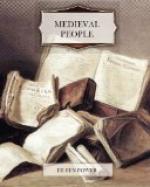2. De Villis, c. 45.
3. Ibid. cc. 43, 49.
4. From ‘The Casuistry of Roman Meals,’ in The Collected Writings of Thomas De Quincey, ed. D. Masson (1897), VII, p. 13.
5. Aelfric’s Colloquium in op. cit. p. 95.
6. The Monk of St Gall’s Life in Early Lives of Charlemagne, pp. 87-8.
7. Einhard’s Life in op. cit., p. 45.
8. Anglo-Saxon charms translated in Stopford Brook, English Literature from the Beginning to the Norman Conquest (1899), p. 43.
9. Old High German charm written in a tenth-century hand in a ninth-century codex containing sermons of St Augustine, now in the Vatican Library. Brawne, Althochdeutsches Lesebuch (fifth edition, Halle, 1902), p. 83.
10. Another Old High German charm preserved in a tenth-century codex now at Vienna. Brawne, op. cit., p. 164.
11. From the ninth-century Libellus de Ecclesiasticis Disciplinis, art. 100, quoted in Ozanam, La Civilisation Chretienne chez les Francs (1849), p. 312. The injunction however, really refers to the recently conquered and still half-pagan Saxons.
12. Penitential of Haligart, Bishop of Cambrai, quoted ibid. p. 314.
13. Documents relatifs a l’Histoire de l’Industrie et du Commerce en France, ed. G. Faigniez, t. I, pp. 51-2.
14. See references in Chambers, The Medieval Stage (1913), I, pp. 161-3.
15. For the famous legend of the dancers of Koelbigk, see Gaston Paris, Les Danseurs Maudits, Legende Allemande du XIe Siecle (Paris 1900, reprinted from the Journal des Savants, Dec., 1899), which is a conte rendu of Schroeder’s study in Zeitschrift fuer Kirchengeschichte (1899). The poem occurs in a version of English origin, in which one of the dancers, Thierry, is cured of a perpetual trembling in all his limbs by a miracle of St Edith at the nunnery of Wilton in 1065. See loc. cit., pp. 10, 14.
16. ‘Swete Lamman dhin are,’ in the original. The story is told by Giraldus Cambrensis in Gemma Ecclesiastica, pt. I, c. XLII. See Selections from Giraldus Cambrensis, ed. C.A.J. Skeel (S.P.C.K. Texts for Students, No. XI), p. 48.
17. Einhard’s Life in op. cit. p. 45. See also ibid., p. 168 (note).




